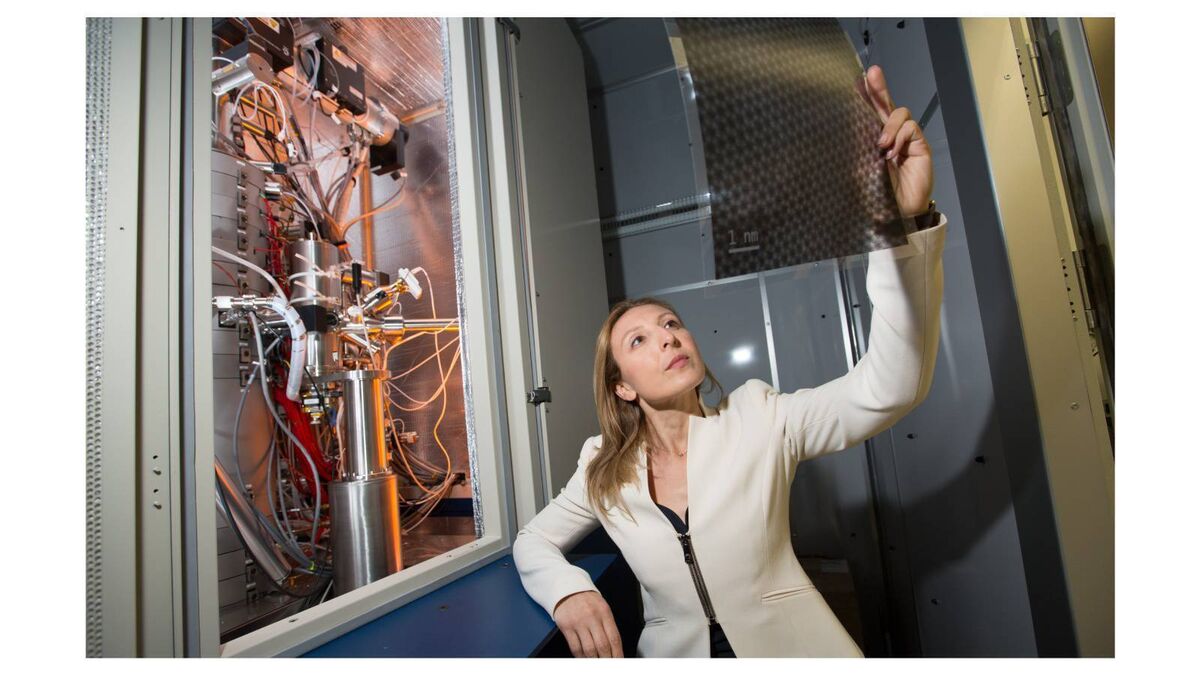Using wood waste in high-tech electromagnetic and biotechnology research

Professor Valeria Nicolosi views an image of graphene — a pure carbon material extracted from graphite, discovered almost 20 years ago. Picture: Naoise Culhane Photography
It's been in use for thousands of years as a construction material, for weapons, and as fuel... so wood might not immediately spring to mind for use in high-tech work such as bioengineering projects or electromagnetic developments.
But wood derivatives are actually key in two projects which just secured European Research Council proof of concept awards.
Professor Valeria Nicolosi’s materials science project ‘E-Wood’ will transform wood waste into high value sustainable electromagnetic interference shielding materials for modern technology.
And Professor Fergal O’Brien’s bioengineering project ‘DEEPSTIM’ is a digitally enabled electroconductive patient specific stimulation implant for spinal cord injury.
Coincidentally both projects will utilise MXene — an emerging 2D material with the rare combination of properties such as electric and metallic conductivity, hydrophilicity, biocompatibility, large surface area, size tunability, rich surface chemistry, flexibility, layered structure. MXene is considered as the building block of the future materials and devices.
AMBER Researchers secure @ERC_Research Proof of Concept Awards. Prof @NicolosiGroup ‘E-Wood’ will transform wood waste into high value sustainable materials Prof @fjobrien ‘DEEPSTIM’ a patient specific stimulation implant for spinal cord injury.#ERCPoChttps://t.co/l2oekgFih6 pic.twitter.com/1HuoNLRrwn
— AMBER (@ambercentre) January 23, 2025
Valeria Nicolosi, Professor of Nanomaterials and Advanced Microscopy, Trinity College Dublin has secured ERC Proof of Concept funding of €150,000 for project ‘E-Wood’ which will transform low-value wood waste into sustainable, high-value, high-performance, electromagnetic interference shielding materials.
As our reliance on electronics grows, so does the need to protect sensitive devices from electromagnetic interference (EMI), which can cause malfunctions or even health risks.
"Traditional materials used for EMI shielding are often made from metals or plastics that aren't always environmentally friendly. The challenge is to find a better, sustainable alternative."

This project aims to address that by developing new, eco-friendly materials for EMI shielding using wood waste and advanced nanomaterials. Each year, millions of tons of wood waste are generated, much of which is not recycled.
"We plan to turn this waste into high-performance inks that can be used in 3D printing to create EMI shielding materials. By combining wood powder with special 2D materials called MXenes, which are known for their excellent electrical conductivity, we can create a strong, flexible, and sustainable solution. This research not only helps protect electronics but also reduces environmental waste, offering a more sustainable approach to modern technology."
Professor Nicolosi said: “Securing funding for this project is a significant milestone, not just for advancing the science of electromagnetic interference shielding, but for taking meaningful steps toward a more sustainable future. I'm excited to explore the potential of wood waste and MXenes as innovative, eco-friendly solutions to a growing environmental challenge. This research has the power to not only protect sensitive electronics but also contribute to reducing electronic waste and promoting a circular economy.”

Professor Fergal O’Brien, Professor of Bioengineering & Regenerative Medicine, and Deputy Vice Chancellor for Research & Innovation at RCSI has secured ERC Proof of Concept funding of €150,000 for project ‘DEEPSTIM’ — a digitally enabled electroconductive patient-specific stimulation implant for spinal cord injury.
Spinal cord injury (SCI) can severely impact patients, impairing neurological function. The complex pathophysiology of SCI and the poor growth capacity of neurons results in a multi-faceted challenge to repair. Lifetime treatment costs for SCI patients can be as high as €2 million and approximately 11,000 new spinal cord injuries occur every year in the EU.
This project envisions a future whereby spinal cord injury patients receive a 3D-printed electroconductive implant matching the anatomy of the damaged regions of their spinal cord. The aim of this project is to develop, test and identify the optimal route to the market of a ground-breaking treatment for spinal cord injury repair consisting of a novel 3D printed patient-specific biomaterial platform for the directed delivery of pro-reparative therapeutic electrical stimulation. This implant will direct targeted electrical stimulation — driving the regrowth of the injured nerve cell and promoting functional recovery.
The Research Ireland Centre for Advanced Materials and Bio-Engineering (AMBER) was established in 2013. These ERC Proof of Concept Awards bring the total ERC awards for AMBER to 34. The combined value of the awards secured by AMBER Researchers to date is approximately €40 million. Professor Nicolosi currently holds eight ERC Awards and Professor O’Brien holds four — with a dozen awards combined their research work has proven pivotal in progressing advances in materials science and bioengineering research and innovations to the benefit of information and communications technology, energy, sustainability, and quality of life and healthcare interventions.
AMBER is hosted by Trinity College Dublin, in partnership with CRANN (Centre for Research on Adaptive Nanostructures and Nanodevices) and the Trinity Centre for Biomedical Engineering, RCSI University of Medicine and Health Sciences, University College Cork, University of Galway, Dublin City University, TU Dublin, Tyndall National Institute, University of Limerick, University College Dublin and the Technological University of the Shannon: Midland West.








